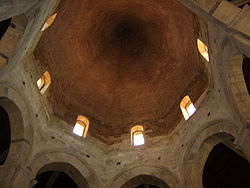
Santo Sepolcro (Pisa)
Encyclopedia


Pisa
Pisa is a city in Tuscany, Central Italy, on the right bank of the mouth of the River Arno on the Tyrrhenian Sea. It is the capital city of the Province of Pisa...
, Tuscany
Tuscany
Tuscany is a region in Italy. It has an area of about 23,000 square kilometres and a population of about 3.75 million inhabitants. The regional capital is Florence ....
, Italy
Italy
Italy , officially the Italian Republic languages]] under the European Charter for Regional or Minority Languages. In each of these, Italy's official name is as follows:;;;;;;;;), is a unitary parliamentary republic in South-Central Europe. To the north it borders France, Switzerland, Austria and...
.
Built in the early 12th century (it is known at least from 1113), it was designed by Diotisalvi
Diotisalvi
Diotisalvi, Deotisalvi or Deustesalvet was an architect from Pisa, Italy, active in the 12th century in Pisa. Little is known of him.- Biography :...
, who also designed the Baptistery of Pisa Cathedral forty years later. It has an octagonal plan and, until the 16th century, it was surrounded by a portico
Portico
A portico is a porch leading to the entrance of a building, or extended as a colonnade, with a roof structure over a walkway, supported by columns or enclosed by walls...
. The central tambour
Tambour
In classical architecture, a tambour is the inverted bell of the Corinthian capital around which are carved acanthus leaves for decoration....
, supported by eight ogival arches, is super-elevated and is surmounted by a conic cusp
Cusp
Cusp may refer to:*Beach cusps, a pointed and regular arc pattern of the shoreline at the beach*Behavioral cusp an important behavior change with far reaching consequences*Cusp catastrophe...
.
The attribution to the Holy Sepulchre is a reference to the latter's relics which were carried in Pisa by archbishop Dagobert
Dagobert of Pisa
Dagobert was the first Archbishop of Pisa and the second Latin Patriarch of Jerusalem after it was captured in the First Crusade.-Early life:...
after his participation to the First Crusade
First Crusade
The First Crusade was a military expedition by Western Christianity to regain the Holy Lands taken in the Muslim conquest of the Levant, ultimately resulting in the recapture of Jerusalem...
. The structure resembles indeed the Dome of the Rock
Dome of the Rock
The Dome of the Rock is a shrine located on the Temple Mount in the Old City of Jerusalem. The structure has been refurbished many times since its initial completion in 691 CE at the order of Umayyad Caliph Abd al-Malik...
in Jerusalem, conquered by the crusaders in 1099.
The portals have decorations with animals and lions' heads in marble. The interior, restored in 1720 in Baroque style, was destroyed in the 19th century. What remains include a bust-reliquary of St. Ubaldesca (15th century) with a pail which, according to the tradition, belonged to the saint; the tombstone of Marie Mancini
Marie Mancini
Anna Maria Mancini was the third of the five Mancini sisters; nieces to Cardinal Mazarin who were brought to France to marry advantageously...
, Mazarin's niece; and a 15th century panel of the Madonna with Child.
The unfinished small bell tower is in Pisane-Romanesque style, with rectangular plan.

